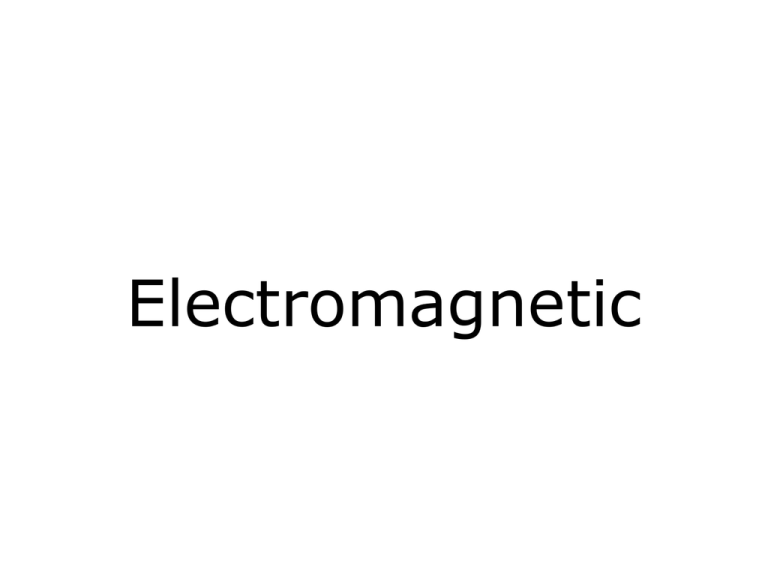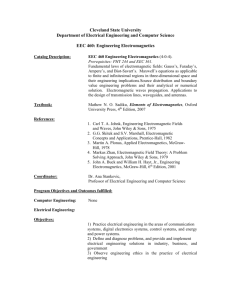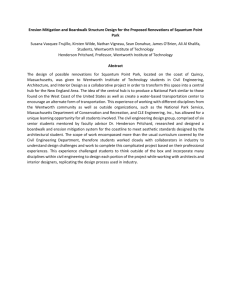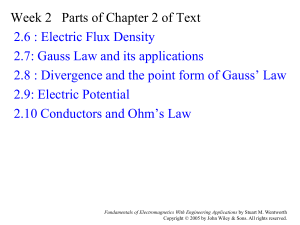
Electromagnetic
Lanjutan SAP
Dari buku Stuart Wentworth:
• Pertemuan 10
Plane Waves: 5.1 -5.4
• Pertemuan 11
Plane waves: 5.5 – 5.8
Dari buku Stuart:
• Pertemuan 12
Transmission lines: 6.1 - 6.3
• Pertemuan 13
Transmission lines: 6.4 - 6.5
• Pertemuan 14
Transmission lines: 6.6 - 6.8
• Pertemuan 15
Waveguide : 7.1 -7.2
• Pertemuan 16
Waveguide : 7.3 -7.4
• Pertemuan 17
Waveguide : 7.5 -7.6
• Pertemuan 18
Antena : 8.1 - 8.4
• Pertemuan 19
Electromagnetic Interference: 9.1 – 9.3
• Pertemuan 20
Electromagnetic Interference: 9.4 – 9.6
Figure 2-47 (p. 77)
Simplified schematic of an electret
microphone circuit.
Figure 3-34 (p. 136)
Cross section of a moving-coil loudspeaker.
Fundamentals of Electromagnetics With Engineering Applications by Stuart M. Wentworth
Copyright © 2005 by John Wiley & Sons. All rights reserved.
Figure 3-53 (p. 159)
Maglev prototype. Courtesy of Transrapid International.
Fundamentals of Electromagnetics With Engineering Applications by Stuart M. Wentworth
Copyright © 2005 by John Wiley & Sons. All rights reserved.
Figure 3-54 (p. 160)
The Maglev concept.
Fundamentals of Electromagnetics With Engineering Applications by Stuart M. Wentworth
Copyright © 2005 by John Wiley & Sons. All rights reserved.
Plane Waves
Learning Objectives
• Derive the general equations for
electromagnetic wave propagation
• Study electromagnetic wave propagation in
conductors and define skin depth
• Describe electromagnetic wave power
transmission using the Poynting theorem
• Define the polarization of an
electromagnetic wave
• Study reflection and transmission of waves
incident from one material to another
Figure 5-1 (p. 210)
At a remote distance away from a point source, the waves appear to be planar.
Fundamentals of Electromagnetics With Engineering Applications by Stuart M. Wentworth
Copyright © 2005 by John Wiley & Sons. All rights reserved.
5.1 General Wave Equations
• Material media that are linear, isotropic,
homogeneous and time invariant
Figure 5-2 (p. 217)
Representation of waves. In (a), the wave travels in the ap = +az direction and has
Es = E0+e-yz ax and Hs = (E0+/)e-z ay. In (b), the wave travels in the ap = –az
direction and has Es = E0-ez ax along with Hs = –(E0-/)ez ay.
Fundamentals of Electromagnetics With Engineering Applications by Stuart M. Wentworth
Copyright © 2005 by John Wiley & Sons. All rights reserved.
5.2 Propagation in Lossless, ChargeFree Media
• Charge-free (v = 0) medium has zero
conductivity( = 0 )
• perfect dielectric is lossless
5.3 Propagation in Dielectrics
• Dielectrics are to some degree lossy
• The lossy nature can be attributed to finite
conductivity, polarization loss or a
combination of the two.
• Low loss dielectrics is one with a small loss
tangent (/<<1)
A standard measure of
lossiness in a dielectric
is given by the loss
tangent.
It is useful for
classifying a material
as either a good
dielectric (tan <<1 )
or a good conductor
(tan >>1 )
Figure 5-3 (p. 222)
Loss tangent tan is the ratio of the conduction to displacement current densities, or
tan = (+”) ’.
Fundamentals of Electromagnetics With Engineering Applications by Stuart M. Wentworth
Copyright © 2005 by John Wiley & Sons. All rights reserved.
5.4 Propagation in Conductors
• In any decent conductor at reasonable
frequencies the loss tangent, / , is much
greater than one.
• Example, stainless steel with a conductivity of
106 S/m.
Figure 5-5 (p. 225)
The portion of an electromagnetic wave incident from air that passes into a
conductor experiences high attenuation and a decrease in wavelength.
Fundamentals of Electromagnetics With Engineering Applications by Stuart M. Wentworth
Copyright © 2005 by John Wiley & Sons. All rights reserved.
Figure 5-6 (p. 226)
Slab of material with length L, width w, and thickness t has conductivity . The top
and bottom faces are covered in equipotential surfaces tied to a voltage supply.
Fundamentals of Electromagnetics With Engineering Applications by Stuart M. Wentworth
Copyright © 2005 by John Wiley & Sons. All rights reserved.
Figure 5-7 (p. 227)
An x-polarized electric field is incident on a semiinfinite slab of material that
occupies z > 0.
Fundamentals of Electromagnetics With Engineering Applications by Stuart M. Wentworth
Copyright © 2005 by John Wiley & Sons. All rights reserved.
Figure 5-8 (p. 228)
The total area under the e-z curve from z = 0 to infinity) is equal to the product of
Exo and .
Fundamentals of Electromagnetics With Engineering Applications by Stuart M. Wentworth
Copyright © 2005 by John Wiley & Sons. All rights reserved.
Figure 5-9 (p. 229)
Plot showing the accuracy of the calculated skin-effect resistance as a function of
slab thickness.
Fundamentals of Electromagnetics With Engineering Applications by Stuart M. Wentworth
Copyright © 2005 by John Wiley & Sons. All rights reserved.
Figure 5-10 (p. 230)
Coaxial cable indicating current
is confined to within a skin-depth
of the conductor surfaces.
Fundamentals of Electromagnetics With Engineering Applications by Stuart M. Wentworth
Copyright © 2005 by John Wiley & Sons. All rights reserved.
Latihan
5.3: A wave with l = 6.0 cm in air is incident
on a nonmagnetic, lossless liquid media. In
the liquid, the wavelength is measured as
1.0 cm. What is the wave’s frequency (a) in
air? (b) in the liquid? (c) What is the
liquid’s relative permittivity?
Answer
(a)
3x108 m s
f
5GHz
0.06m
up
c
(b) the frequency doesn’t change with the
media (the wavelength does) so f = 5 GHz
(c)
c
9 1
7 m
u p f 5 x10 0.01m 5 x10
s
2
3x10
r
36
8
0.5 x10
8
s
r
Terima kasih
Selesai






